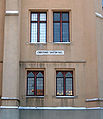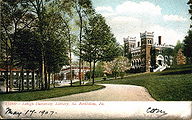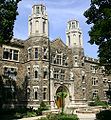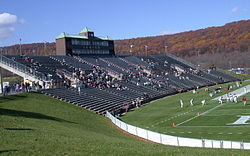- List of Lehigh University buildings
-
"Taylor College" redirect here. For the university college in Malaysia, please see Taylor's University College
Lehigh University has many buildings, old and new, on its three campuses. When the university was founded in 1865, it took over several buildings from the surrounding property. One which remains today is Christmas Hall, now part of Christmas-Saucon Hall.[1] In 2010, the university completed the construction of a new multidisciplinary facility for Science, Technology, Environment, Policy, & Society (STEPS).[2] The 135,000-square-foot (12,500 m2) $62.1 million green building is located on the southwestern corner of the Maginnes lawn.[3]
Building Codes Code Name CO Coppee Hall CU Chandler Ullmann Bldg CX Coxe Hall DR Drown Hall FM Fairchild-Martindale Lib FR Fritz Lab GR Grace Hall IA Iacocca Hall IL IMBT Lab LA Lamberton Hall LI Linderman Library LL Lewis Lab MG Maginnes Hall MO Mohler Building MU Mudd Building NV Neville Hall PA Packard Lab PH Philosophy Building PR Price Hall RB Rauch Business Center SI Sinclair Lab ST STEPS* TA Taylor Gym UC University Center WB Wilbur Workshop WH Whitaker Lab WI Williams Hall XS Christmas Saucon Hall ZA Zoellner Arts Center Asa Packer Campus
The original campus contains most of Lehigh's academic and residential buildings and sits on the north slope of South Mountain overlooking Bethlehem's Southside. It has expanded many times during Lehigh's history as surrounding land has been purchased and as existing buildings around the campus have been acquired and converted. During recent years, intense work has been done on this campus. This has included the construction, expansion, or renovation of several buildings and significant improvements in traffic flow and pedestrian areas.
Alumni Memorial Building (1925)
The Alumni Memorial Building is a Gothic building near the center of campus, housing the Visitor Center, the Office of Admissions, and the Alumni Association. The building is a memorial to the 1,921 Lehigh alumni who served in World War I and the 46 who died. Plaques commemorating those who served in subsequent wars are situated in the lobby. The building was designed by Lehigh alumni Theodore G. Visscher and James Lindsey Burley.
Campus Square (2002)
A relatively new complex of buildings on the northern edge, Campus Square consists of apartment style undergraduate housing, the university bookstore, retail space, and a parking garage. Its architecture reflects some changing attitudes towards southside Bethlehem by breaking the tradition of creating a visual wall between the campus and city and instead incorporating a plaza that opens out to the city along the New Street corridor.
Centennial Complex (1965, 1971)
The six "Upper Centennials" (Congdon, Emery, Leavitt, McConn, Smiley and Thornburg) were built in 1965 for the university's 100th anniversary. They were originally 44 man upperclass residences, which selectively recruited rising freshman to join them. The Centennials competed in intramurals, had social dues and parties, elected officers and had a similar structure to the Greek fraternities. They proved so popular that construction of six more was started in 1969 (the "Lower Centennials"). However, the introduction of co-education resulted in three of the new ones becoming Lehigh's first female residences in 1971 and the remaining three becoming non-selective men's residences.
Chandler-Ullmann Hall (1883, 1938)
These adjoining buildings formerly were the William H Chandler Chemistry Building (1883) and the Harry M. Ullmann Chemistry Laboratory (1938). William Chandler was appointmented as professor of chemistry in 1871 and retired in 1905; during this time he guided the department and gained a national reputation for his work. The building was home to the Department of Chemistry until it moved into the new Seeley G. Mudd Building in 1976; currently the Department of Art, Architecture and Design and the Department of Psychology are located in Chandler-Ullmann. The structure is considered by some architectural historians to be the first "modern" laboratory because of its system of ventilation and the design of its laboratories. The building, which won a prize for design at the Paris Exposition of 1889, was designated a National Historical Chemical Landmark by the American Chemical Society in 1994.
Christmas-Saucon Hall (1866, 1872)
Originally a church, Christmas Hall is the oldest structure on the Lehigh University campus and pre-dates the founding of the University. The first classes were held here on September 3, 1866. The building served as a chapel, classrooms, and dorms during the university's early years. In 1872 Saucon Hall was built a few feet to the east of Christmas Hall and the two structures were connected by a hyphen in 1927. It is now home to the Mathematics Department.
Coxe Hall (1910)
Named after Eckly Brinton Coxe, it was originally a mining laboratory. The building completed massive renovations in 2004 and was turned into the Baer International Center, housing the ESL department, the Global Union, and the Study Abroad offices.
Drown Hall (1908)
Originally the student center and later home of the business school before the creation of Rauch Business Center, Drown Hall is now the home of the English Department. It also has a student writing help center in the upper floor. It was named after university president Thomas Messinger Drown.
E.W. Fairchild-Martindale Library and Computing Center (1969, 1985)
A high technology edifice near University Square, is of modern design and houses science and engineering holdings, the Media Center, library and technology services staff, a computer center, and the Digital Media Studio. The original part of the library, now FM-S, was constructed in 1969 as the Mart Science and Engineering Library, named after Leon T. Mart, Thomas L. Mart, and Clara W. Mart. An addition that more than doubled the size of the library was completed in 1985 and the library was renamed after Harry T. Martindale, a Lehigh alumni, and his wife, Elizabeth, daughter of the late Edmund W. Fairchild, founder of a business-publications and communications empire. The center contains three very powerful supercomputers known as the HPC group: Altair,Inferno,and Blaze.
Lewis Laboratory (1895)
Lewis Lab is 235 feet (72 m) in length and 5 stories high. The building is home to the Lehigh physics department, and named after William Deming Lewis. The building was destroyed by fire in 1900 and immediately rebuilt. The fire was due to curtains catching fire near an optics experiment. Due to communication problems, adequate equipment to put out the fire did not arrive until it was too late to save much of the building. It now houses a large lecture hall on the second floor, laboratories on the first and second floors, classrooms on the third floor, offices on the fourth floor, and more classrooms and laboratories on the fifth floor. It is also home to the advanced optics lab. It is part of the Sherman Fairchild Center for the Physical Sciences, a three-part continuous building consisting of the historic Lewis Lab, the Sherman Fairchild Lab, and the auditorium and hallways (generally considered part of Lewis Lab) that serve as a connector between the two main building sections and the main entrance to the complex.
Linderman Library (1877)
Designed by Philadelphia architect Addison Hutton and built by founder Asa Packer as a memorial to his daughter, Lucy Packer Linderman. The original rotunda is surrounded except on the south by a major addition constructed in 1929 that was designed by Theodore C. Visscher and James L. Burley. The building houses more than 20,000 rare books and volumes related to the humanities and social sciences. The building was closed for extensive renovations from May 2005 until March 19, 2007 under the architects MGA Partners. The renovations added new classrooms and seminar rooms, a humanities commons, new computer technology, wired and wireless networking spaces for students working on team projects, a cafe, new climate control systems to preserve the collections and provide a comfortable environment for students, faculty and staff, and also enhanced building access and navigation for handicapped users. The renovation also opened up the top floor which had previously been closed to the public.
McClintic-Marshall House (1957)
McClintic-Marshall House, commonly referred to as M&M, is a four story, H-shaped building composed of sandstone. This dormitory was completed in 1957 by architect Frederick Larson. The structure was built in memory of Howard H. McClintic and Charles D. Marshall who both graduated from Lehigh University as Civil Engineers in 1888.
M&M is currently a freshman-only dorm, coeducational by section. The first floor serves as the main entry-way into the building. Located on the left (A) wing is a game room/lounge area with a billiards table, ping-pong table, some sofas, and a widescreen flat-panel plasma television. The right (B) wing of the ground floor has a luggage storage room and two laundry rooms. The top three floors provide residence to about 92 students each, making a total of 276. Each floor has two sections following the A and B layout which are separated by a shared lounge/study area. The sections are referenced by the wing followed by the floor number, i.e. A2 is the A wing of the second floor. Floor numbering is G, 1, 2, 3.
Packard Laboratory (1929)
Named after James Ward Packard, one of the inventors of the first Packard automobile, this building is designed in the gothic style. It currently serves as the headquarters for the P.C. Rosin School of Engineering and Applied Sciences. Within the building are several large lecture halls, an exhibit of the first Packard automobile, and many laboratories.
Packer Memorial Church (1887)
Packer Memorial Church is an Episcopal church on campus. On Sundays, Roman-Catholic mass is usually held at 9:00 pm in the chapel. It is also available for weddings in which at least one of the parties is a Lehigh University student or alumnus. It used to be the location of the freshman convocation which is held during orientation at the beginning of each school year, however due to the growing class size, in 2007 convocation was moved to the larger Baker Auditorium in the Zoellner Arts Center.[1]
Packer Hall, the University Center (1868)
When it was first built, it housed a chapel, classrooms, offices, drafting rooms, and dormitories. It was the first building specifically built for Lehigh University. It now houses student and faculty dining facilities, food courts, deans' offices, the military science (ROTC) department, the Women's Center, The Center for Academic Success, Office of Multicultural Affairs, The Rainbow Room (LGBTQA Programs and Outreach), a bank office, and conference facilities.
The Quad (1938-1948)
Previously called the "Freshman Quad", the classic collegiate stone residence halls of Dravo House, Drinker House, and Richards House now house both upperclass and freshman residents.
Rathbone Hall (1972)
Completed in 1972 and named after Monroe Jackson Rathbone, it is modern in appearance and seems to hang off the mountain, being built in a very steep section and having ground floor access to each of its floors. The main part of the building is one of Lehigh's dining halls, offering sweeping views of the Lehigh Valley from the dining room. The lower floors of the building house offices and service areas.
Rauch Business Center (1990)
Home of the university's College of Business and Economics, comprises 115,000 square feet (10,700 m2) of floor space on five stories and also houses the Career Services Office, and the Perella Financial Services Lab. Opened in 1990 on the site of the former Taylor Stadium. It is named after Philip Rauch.
Sayre Park (1997)
The upper half of the Packer Campus is Sayre Park, commonly called "The Hill". Originally parkland this area has now houses all Greek houses as well as the Sayre Park Residential Complex which houses 146 upperclassmen in 3 residential buildings and one common building.
STEPS Building (2010)
The 135,000 square feet (12,500 m2) building on the corner of Packer Avenue and Vines Street was opened on August 2010.[4] STEPS stands for "Science, Technology, Environment, Policy and Society," and contains classrooms and laboratories mostly for the Earth & Environmental Science, Civil and Environmental Engineering, Chemistry and Biology departments. STEPS is supposed to represent “science in sight” so many of the labs are open. The Open style of the building is meant to represent and foster the open discussion from the various departments in the building. It contains many "green" features, including low flush toilets, heat shields to recycle energy from fume hoods, exhaust fans, and green roof to prevent soil runoff and hold in heat/AC. Outside STEPS there is a petrified tree stone that is over 360 million years old.
Taylor College (1907)
"Taylor College" redirects here. For the university college in Malaysia, please see Taylor's University CollegeTaylor College is a dormitory for upperclass students at Lehigh University. It houses 145 students from sophomores through juniors in coeducational hallways. What makes Taylor different from other upperclassmen living units is its integration with the Healthy Living program. Residents have the option of participating in the program or treating it as a traditional dorm.
Taylor, as the building is commonly named, is located next to the McClintic-Marshall House and across from the Trembly Park Apartments. It is shaped in a U divided into three sections. Each of these sections has lounge called either the red, blue, or green lounge. The lounges contain a small kitchen and a television set. Many of the rooms in Taylor Hall are doubles, interspersed with several singles throughout the building.
Taylor "is one of the earliest concrete structures ever built. It was the gift of industrialist Andrew Carnegie in honor of his friend and associate, Lehigh trustee Charles L. Taylor, Class of 1876." In 1984 the building underwent a complete renovation.[5]
Taylor Gymnasium (1907)
The Taylor Gymnasium is home to the Lehigh Athletics Administrative and Coaches offices. It houses the Welch Fitness Center, Basketball Courts, Swimming Pools, Studio (Multi-purpose room), Locker Rooms, Penske Lehigh Athletics Hall of Fame, the Athletics Partnership, Athletic Store, and Youth Camps/Clinics Office. This building is named after Charles L. Taylor, although it sits on a street named Taylor, after the U.S. President.
Taylor Stadium (1914-1987)
Named after Charles L. Taylor, it was designed by architect Henry Hornbostel and engineer Charles W. Leavitt. It sat at the intersection of Taylor Street and Packer Avenue, and was demolished in 1987 for the construction of the Rauch Business Center.
Ulrich Student Center / Grace Hall (1942, 1994)
Grace Hall is home to Lehigh's nationally ranked wrestling and women's volleyball programs. The facility, known as "The Snake Pit," recently underwent a substantial renovation and re-opened in November 2003. The building's lower level, renamed Leeman-Turner Arena at Grace Hall, seats 2,200 and is also used for intramural and club sports, concerts and lectures. The upper level houses the Ulrich Student Center, including a movie theater, post office, and the studios of WLVR. In 2007 mold was discovered in the floor of the Leeman-Turner Arena. The entire gym floor had to be replaced, which wasn't completed until November. The cost of the repairs is unknown but expected to be "substantial". The building's upper floor was home to the ROTC and AFROTC departments from 1941–1994 and was dedicated as the Ulrich Student Center on 7 April 1995. It is named after Ronald J. Ulrich and Eugene Gifford Grace.[6]
Whitaker Laboratory (1960)
Built in 1960 and named after Martin Dewey Whitaker, it was originally the metallurgy and chemical engineering building. The Metallurgy Department has since become the Materials Science and Engineering Department, and is now the sole department in the building. Whitaker Lab consists of two major wings, the south wing a two floor section containing three lecture halls and the main entrance to the building, and the north wing, which is five floors high and contains offices, classrooms, and labs. The two wings are connected by an elevated walkway on the third floor. It is connected to the Mudd Building by an underground tunnel on the first floor.
Zoellner Arts Center (1997)
Zoellner Arts Center is a 105,000-square-foot (9,800 m2) arts center located on the campus of Lehigh University in Bethlehem, Pennsylvania, in the United States. It opened in 1997, and houses the following facilities:
- Baker Hall - a 946-seat auditorium with multi-purpose proscenium stage, suited for concerts, stage productions, ceremonies and lectures.
- Diamond Theater - a small 309-seat 3/4 thrust theater with steeply raked stadium seating suited for theatrical and small music groups.
- Black Box Theater - a smaller 125-seat theater
- A two-story art gallery
- Additional facilities including several rehearsal rooms, recording studio, dance studio, practice rooms, scene shop, costume shop, dressing rooms and green room, classrooms, music library, box office, faculty and staff offices, and three large lobbies and a 345-car parking deck attached to the building.
- It is also home to the Music and Theater Departments.
The venue has had a wide array of performers, including: the New York Philharmonic and Itzhak Perlman, the Tuvan throat singers Huun-Huur-Tu and Laurie Anderson, Hubbard Street Dance Chicago, MOMIX, the Aquila Theatre Company, Lily Tomlin, Bernadette Peters and Queen Latifah.
The building was designed by Dagit Saylor Architects in Philadelphia, and is named after Victoria E. and Robert E. Zoellner.
Mountaintop Campus
Originally built as the Homer Research Labs of Bethlehem Steel, this 742-acre (3.00 km2) campus was acquired by Lehigh in 1986 and is home to the College of Education and numerous facilities for the Civil Engineering, Chemical Engineering, and Biological Sciences departments.
Iacocca Hall (1958)
Originally built as the Homer Research Labs of the Bethlehem Steel Corporation, it is also known as the tower building and houses the College of Education, the chemical engineering department, the biological sciences department, as well as a dining room and food services facilities, plus a teleconferencing classroom.
Imbt Laboratories
This building hosts the Advanced Technology for Large Structural Systems (ATLSS) Engineering Research Center and the Energy Research Center.
Sayre Field (1966)
Located atop South Mountain, the field is used for intramural sports.
Murray H. Goodman Campus
Primarily a sports campus, it contains most of Lehigh's athletic facilities and its only on-campus graduate housing. The Goodman Campus sits on the relatively flat lands of Saucon Valley south of South Mountain and across Interstate 78 from the other two campuses.
Murray H. Goodman Stadium (1988)
A 16,000 capacity stadium, it features a three-tiered press box and limited chair back seating. With views of South Mountain, it has been named "Best Game Atmosphere" by a Patriot League publication.
Ulrich Sports Complex (1999)
A dual field complex for men's and women's soccer, men's and women's lacrosse, and field hockey. The complex features natural grass as well as artificial turf. Permanent seating, a press box and lighting are available.
Stabler Arena & Convocation Center (1979)
A 6,000 capacity arena for concerts, sports (including Lehigh's basketball teams), and other events.
Rauch Field House (1977)
Provides indoor practice fields, an indoor running track, and locker rooms for the various teams.
Mulvihill Golf Learning Center (2007)
Provides a driving range, practice bunkers, and putting greens for developing golf skills. Lehigh's home course for golf meets is the nearby Saucon Valley Country Club which has hosted the USPGA Senior Open and the LPGA Women's US Open.
Notes
- ^ a b W. Ross Yates, Sermon in Stone, http://www.lehigh.edu/~incha/yates.html
- ^ Lehigh university STEPS initiative.
- ^ Lehigh STEPS up to global challenges, Lehigh University - UR News Story, published Thursday, October 16, 2008.
- ^ "STEPS Facility". Lehigh University. http://www3.lehigh.edu/steps/facility/index.html. Retrieved September 14, 2010.
- ^ "Taylor College". Lehigh University Housing. 2006. http://www3.lehigh.edu/studentlife/housing/taylor.asp. Retrieved 2006-08-15.
- ^ Eugene Gifford Grace
Categories:- Lehigh University buildings and structures
- Lehigh University
Wikimedia Foundation. 2010.





























